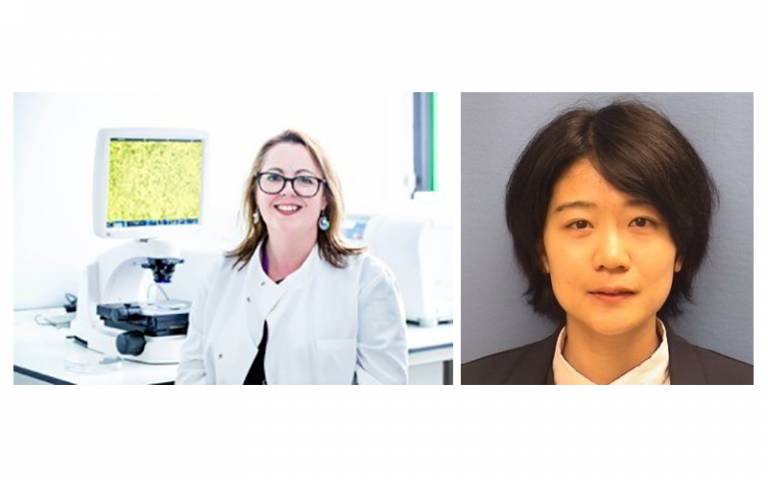Two new lecturers appointed at UCL IoO
7 April 2020
The UCL Institute of Ophthalmology (IoO) is pleased to announce the appointment of Dr Amanda Carr and Dr Yujiao Jennifer Sun

Dr Amanda Carr will take up her position in August. Dr Carr is an expert in RPE biology, and has led stem cell and RPE differentiation research at UCL Institute of Ophthalmology. She uses RPE models to study the mechanism of disease and develop potential therapies, with a particular interest in Bestrophinopathies and AMD.
Dr Jennifer Sun will be joining us from the University of California San Francisco, in July. Dr Sun uses in vivo systems approaches to elucidate how neuromodulation regulates information processing and neuroplasticity. She applies computational, physiological, pharmacological and molecular manipulation, with imaging approaches to identify the underlying biological basis of visual cortical plasticity.
We asked Dr Carr and Dr Sun for their comments on the new appointments:
“It’s a dream come true to have the opportunity to advance my research programme at the UCL Institute of Ophthalmology. I’m really looking forward to working with world-class research teams and clinicians to develop cutting edge strategies to understand and treat blindness. Dr Amanda Carr
I am excited to start my Visual Plasticity Lab at UCL IoO, aiming to answer how visual cortex integrates sensory and non-sensory modulatory information to regulate plasticity. I envision productive interaction with researchers studying glia cells in the institute and greater UCL community to elucidate the role of neuron-glial interaction in this dynamic process. I also anticipate working with researchers and clinicians at IoO and Moorfields to understand how neuroplasticity differs in health and disease to help promote vision recovery from aging, injury, and neurological disorders. Dr Yujiao Jennifer Sun
Biographies
Dr Amanda Carr
Amanda completed a PhD in Neuroscience at the University of Manchester, examining the effects of light on biological clocks with Professor Andrew Loudon. In 2002 she moved to Professor David Whitmore’s lab in the UCL Department of Anatomy and Developmental Biology, where she studied light driven biological rhythms in vertebrate cells.
Amanda moved to the UCL Institute of Ophthalmology in 2006 to investigate the therapeutic potential of retinal pigment epitheliium (RPE) cells, initial work focused on RPE transdifferentiation to produce retinal cells. She later began work with The London Project to Cure Blindness, contributing to the development of a cellular therapy for age-realted macular degeneration using human embryonic stem cell-derived RPE.
In 2015 Amanda was awarded a UCL Sensory System and Therapeutics Fellowship and a Macular Society project grant to establish her independent research programme using induced pluripotent stem cells to model RPE diseases. This work is providing important insights into the cellular and molecular mechanisms behind vision loss and new approaches to treat degenerative and inherited blindness.
Dr. Yujiao Jennifer Sun
Jennifer completed her undergraduate thesis at Peking University in 2007 studying visual circuit assembly with computational modeling to. In 2013, She obtained her PhD degree from University of Southern California with Drs. Li Zhang and Whit Tao studying sensory processing and development in auditory and visual cortices using both computational and systems approaches. She subsequently did her postdoc training at University of California San Francisco with Drs. Roger Nicoll and Michael Stryker, using electrophysiology and two-photon imaging to study neuroplasticity in brain slice and awake-behaving mice.
Dr. Sun will join UCL Institute of Ophthalmology in July 2020. The Sun laboratory aims to apply advanced imaging techniques and multidisciplinary approaches to study neuroplasticity and modulation in the visual cortex. Particularly, we aim to answer how this process is regulated by sensory and neuromodulatory pathways across the brain and achieved through interaction with local environment like interneurons and glial cells.
 Close
Close

